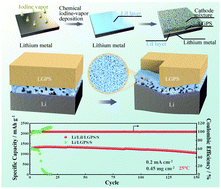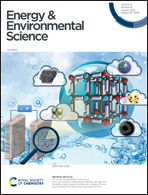Realizing the compatibility of a Li metal anode in an all-solid-state Li−S battery by chemical iodine–vapor deposition†
Abstract
Artificial solid-electrolyte interlayers (SEIs) are extensively used to improve the chemical interfacial stability at the Li/solid state electrolyte (SSE) interface. However, severe mechanical failures of the SEI, namely, Li dendrite penetration caused by uneven Li deposition and bending fracture arising from infinite Li volume change, still challenge the Li/SSE interface. Herein, an elongated rice-shaped nano-LiI crystal densely interweaving structured LiI layer is fabricated at the Li/SSE interface through a smart chemical iodine-vapor deposition method. The LiI layer with such a unique structure shows excellent toughness and high mechanical strength, avoiding mechanical failure accidents and maintaining a robust Li/SSE interface over long cycles. In addition, it shows satisfactory ionic conductivity and high stability against both Li metal and SSE. Consequently, the all-solid-state Li−S battery with a LiI layer exhibits a high discharge capacity of 1360 mA h g−1 at 0.2 mA cm−2 and a capacity retention of 80.6% after 150 cycles. Even under a harsh condition of high areal capacity of 1.35 mA h cm−2 and high temperature of 90 °C, the full cell presents excellent stability over 100 cycles.



 Please wait while we load your content...
Please wait while we load your content...